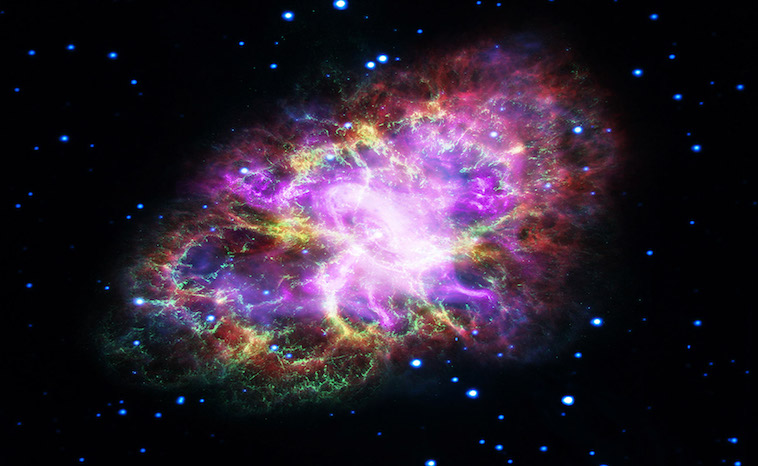Pulsar and the Crab Nebula

In 1967, a team of scientists discovered pulsing stars. Read on to learn more about their discovery and what we have learned since.
It has been 52 years since Jocelyn Bell, a graduate student at Cambridge University in England, found a peculiar pattern in data from a radio telescope. Unlike other radio signals from celestial bodies, this showed a series of regular pulses. In November 1967, Ms. Bell took her findings to her team leader, Anthony Hewish. Together they found three more objects in the sky pulsing with different periods. They named the objects pulsars, which stood for pulsing stars. One year later, they discovered a pulsar in the Crab Nebula.
Pulsar and the Crab Nebula
The Crab Nebula is the remnant of a star that was observed to explode in 1054 A.D. It is located 6,000 light-years away in the constellation of Taurus. It is a strong source of wavelengths from radio waves through gamma-ray waves. The center of the Crab Nebula contains a rapidly rotating neutron star or pulsar. How did scientists know that the pulsar was a neutron star?
Astronomers calculated that the pulses only lasted 0.001 seconds. Consequently, this placed a limit on the size of the object producing the pulse. They determined that the object making the pulse could not extend past 300 km (190 miles) in diameter. As a result, only a neutron star would meet the requirement of a pulsar. Having this knowledge, scientists set out to find a neutron star. In 1968, they found a pulsar at the heart of the Crab Nebula.
What Is A Neutron Star?
According to NASA, a neutron star is formed by the extreme conditions created in a supernova. As a massive star explodes, it sends most of the star into space. However, the core of the star is compressed. This compressed core rapidly spins about 30 times a second. The collapse and rapid rotation of the neutron star cause it to become highly magnetized. A magnetized, rapidly rotating neutron star such as the Crab pulsar can produce electric voltages of 10 quadrillion volts. (NASA 2019)

Evolution of A Pulsar
When the Crab pulsar first formed, it spun fast, perhaps a hundred times a second. As a result, the energy the pulsar radiated into space came from its energy of rotation. It blasted beams of radiation outward, and its rotation slowed.
Astronomers believe that the Crab pulsar is so powerful that is it emits photons all across the electromagnetic spectrum.
“Photons-a particle representing electromagnetic radiation.”
The photons coming from the Crab pulsar include radio, infrared, visible, X-ray, and gamma-ray wavelengths. Careful measurements of its brightness with high-speed instruments show that it blinks twice for every rotation. As one beam sweeps almost directly over Earth, astronomers detect a strong pulse. However, half a rotation later, the edge of the other beam sweeps over Earth. This beam has a weaker pulse.
NASA Pulsar in the Crab Nebula
NASA has tracked the Crab Pulsar for many years. An image taken by NASA’s Chandra X-ray Observatory provides significant clues to the workings of the pulsar. One finding reveals that it produces energy at the rate of 100,000 suns.
Recently, astronomers discovered that the pulsar’s spin does not stay consistent. They believe that the inner portion of the core moves outward, causing the star to spin faster. What causes this? Astronomers are not sure but are looking into this phenomenon. We will have to wait to learn more about these amazing spinning stars.
